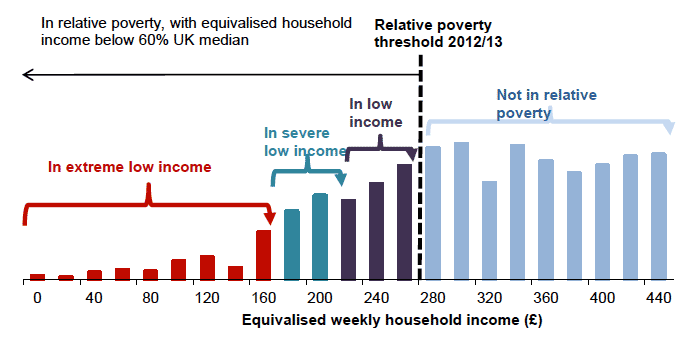Severe Poverty in Scotland
This report investigates the extent of severe and extreme poverty and how it has changed over time for different population groups, in the context of a decade when relative poverty has been falling in Scotland.
SECTION B: DEPTH OF POVERTY IN SCOTLAND IN 2012/13
Introduction
The relative, severe and extreme poverty thresholds are not, as noted in the previous section of this report, distinct categories.
Therefore, in order to understand differences in the depth of poverty, an alternative approach is needed. This analysis is based on three income bands - low income, severe low income and extreme low income, as follows:
- Low income - this is defined as households with equivalised income between 50 - 60 per cent of UK median income. In 2012/13, this was a household income of £11,500 - £13,799;
- Severe low income - defined as households with equivalised income between 40 - 50 per cent of UK median income. In 2012/13, this was a household income of £9,200 - £11,499;
- Extreme low income - defined as households with equivalised income below 40 per cent of UK median income. In 2012/13 this was a household income of below £9,200.
Note that all individuals with equivalised incomes within these bands would be classed as living in relative poverty in 2012/13, using the official definition.
The diagram below shows the bottom half of the income distribution for Scotland in 2012/13 - all households with income between zero and the Scottish median income (£440 per week in 2012/13).

All those with weekly household income less than £264 are in relative poverty (60% UK median income). Of those in relative poverty, households with income between 50% - 60% UK median income are classed as in low income; those with income between 40% and 50% UK median as classed as in severe low income; and those with income less than 40% UK median are classed as in extreme low income.
This section considers these income bands with specific reference to all individuals and the following population sub-groups - working age adults, children and pensioners.
Population groups living in severe and extreme low income in Scotland
Table 3 below shows, for people in poverty, the percentage of individuals and those within population sub-groups in the low income, severe low income and extreme low income bands in 2012/13, before housing costs.
Taking all individuals in relative poverty first, the largest group is in the low income band, closest to the poverty threshold. Nevertheless, over half of those in poverty are in severe or extreme low income.
Table 3: Of people in poverty, proportion of group in low income, severe low income and extreme low income BHC 2012/13
| Percentage in low income | Percentage in severe low income | Percentage in extreme low income | ||
|---|---|---|---|---|
| All individuals | 38% | 34% | 28% | 100% |
| Children | 46% | 37% | 17% | 100% |
| Working age adults | 32% | 33% | 35% | 100% |
| Pensioners | 46% | 33% | 21% | 100% |
Source: HBAI 2012/13, DWP
Looking at population groups gives a different picture. Working age adults were more likely than children and pensioners to have extreme low incomes and were significantly less likely to be in the low income band than the other groups. Two-thirds of working age adults in poverty were living in households with severe or extreme low incomes in Scotland in 2012/13.
The depth of poverty for children and pensioners is less marked than that for working age adults. The proportion of children and pensioners living in households in extreme low income was significantly lower than for working age adults, with nearly half of both these groups in low income. It is nevertheless worth emphasising that, in 2012/13, 17 per cent of children in poverty and 21 per cent of pensioners in poverty were in extreme low income.
Table 4 presents the same information, but after housing costs (AHC) are taken into account. Housing costs in Scotland include rent (gross of housing benefit); mortgage interest payments (net of tax relief); structural insurance premiums (for owner occupiers); and ground rent and service charges.
Table 4: Of people in poverty, proportion of group in low income, severe low income and extreme low income AHC 2012/13
| Percentage in low income | Percentage in severe low income | Percentage in extreme low income | ||
|---|---|---|---|---|
| All individuals | 29% | 21% | 50% | 100% |
| Children | 34% | 27% | 39% | 100% |
| Working age adults | 24% | 20% | 56% | 100% |
| Pensioners | 46% | 19% | 35% | 100% |
Source: HBAI 2012/13, DWP
After housing costs, the picture for all individuals - and all population groups - is more stark. Half of all individuals in poverty were in extreme low income in 2012/13 after housing costs are taken into account.
Of the population sub-groups, working age adults in poverty are most likely to be in extreme low income, with over half of working age adults in extreme low income after housing costs. Four in ten children in poverty and just over one third of pensioners in poverty were in extreme low income after housing costs. However, pensioners in poverty are significantly more likely to be in the low income band than the other groups, after housing costs had been accounted for. In large part, this is because owner occupier pensioners tend to have either low mortgages or own their properties outright.
Contact
Email: Stephen Smith
There is a problem
Thanks for your feedback